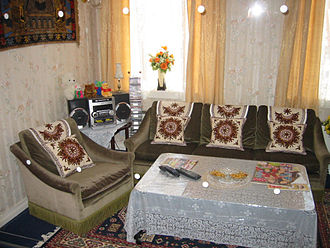Norsk Folk Museum

The Norsk Folkemuseum (translated: Norwegian Folk Museum) on the Bygdøy peninsula in Oslo is Norway's central cultural and historical museum .
history
The museum was founded on December 19, 1894 in Kristiania, today's Oslo , on the initiative of the librarian Hans Aall (1869-1946). The model was the Nordic Museum in Stockholm , which had existed since 1873 , was given its current name in 1880 and was expanded to include the Skansen open-air museum in 1891 . Hans Aall's vision was a Norwegian parallel that was supposed to collect and exhibit “everything that illuminates Norwegian folk cultural life”. All material traces of human life and work in town and country should be preserved, researched and communicated through exhibitions and publications.
The museum opened its first exhibition in 1896 in an apartment at Christian IVs gate 13. In 1898 the museum bought a piece of land on Bygdøy and began rebuilding several village houses that had already been bought for a planned museum. It was important for the choice of the property that it was in the vicinity of the building collection compiled by King Oskar II in 1881 , which can be considered the first open-air museum in the world. In 1907 the museum was able to organize this ensemble of Oskars II. a. the medieval stave church of Gol, add to its own holdings.
To make room for the growing collection, the property was expanded in 1914 and a new museum building was built. At the same time they began to buy up townhouses, which were taken down piece by piece and put up again in a so-called "old town" ("Gamlebyen"), with streets specially laid out. After an architectural competition , the large complex around the museum's market square was created in 1934–1938. In the following years the open-air museum was greatly expanded with the aim of showing complete farms from 15 regions of Norway; however, the plan was never completed.
After Hans Aall's death, Reidar Kjellberg was director of the Folk Museum from 1946 to 1975. His successors were Hallvard Bjørkvik (1975–1989), Erik Rudeng (1990–2000), Liv Hilde Boe (2000–2001) and Olav Aaraas (since 2001).
present
The collections and the open-air museum continued to grow in the post-war period. Buildings were added to the “old town”, giving way to Oslo's urban renewal. The last addition was a tenement house , which was rebuilt between 1999 and 2002 and which had previously stood at Wessels gate 15 in the east of Oslo. By 2009, apartments will be set up in the building on three floors, which will give an overview of Norwegian living culture from around 1880 to the present day.
In 1990 the museum took over large parts of the Norwegian collections from the Nordic Museum. For the 100th anniversary in 1994, the museum was able to use a new visitor center and new magazines. A museum dedicated to the Norwegian painter Frits Thaulow , the Norwegian Museum of Pharmaceutical History and the Ibsen Museum at Henrik Ibsens gate 26 are part of the collection.
The museum also manages the buildings and the park at Bogstadhof in Sørkedalen through its own foundation . In 2004 the Norwegian Folk Museum took over the management of the Royal Landscape Park, the paths and the company buildings, but not the court and private park of the royal family.
In addition to the houses and exhibits mentioned, the first meeting room of the Norwegian Storting , a gas station from 1928, a post office, a dentist's practice and Sámi folk culture objects can be viewed today . The collections now include 155 historical buildings from the Middle Ages to the modern age and approx. 155,000 items.
The Norwegian Folk Museum was owned by an association from the beginning, but was converted into an independent foundation with an affiliated association in 1990, which currently (2006) has around 2000 members. The museum is mainly financed by government grants. Most recently (2004) it registered 266,176 visitors a year. Since 1943 the museum has published the yearbook By og Bygd (City and Country).
See also
literature
- Paal Mork (Ed.): Norsk Folkemuseum - the open-air museum. (= By og Bygd. 43). Norsk Folkemuseum, Oslo 2011, ISBN 978-82-90036-82-4 .
Web links
Coordinates: 59 ° 54 ′ 35.4 " N , 10 ° 41 ′ 6.9" E

